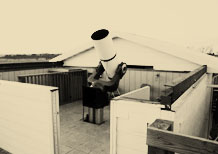
Belle Gunness tale drenched in blood and mystery
October 30, 2011
Most towns shy away from any macabre figures in their history, but LaPorte allows the legend of Belle Gunness to flourish.
While Belle isn't as well known as some infamous criminals and madmen, elements of her deadly deeds are standard in crime and horror stories.
The LaPorte Historical Museum's downstairs floor houses newspaper clippings and relics that tell Belle's blood-curling tale. Also on display is a portion of a shed from her LaPorte farm and a re-creation of Belle herself. Inside the shed is a wheelbarrow, a tool she allegedly used to transport the bodies of her victims.
Belle Gunness was born in Norway in the late 1850s and arrived in America about 1881. She eventually found herself in the Midwest. About 1883, she married fellow Norwegian Max Sorensen and made a home in Austin, Ill. Belle started a lodging house in Chicago, which caught fire and left her with a big insurance claim. Soon, another attempt she made at a business ended in fire, and she received more money.
Max passed away in 1900--on the only day his two life insurance policies overlapped. Authorities were not suspicious of the death and did not call for an autopsy. Belle moved to LaPorte in the early 1890s to start a new life for herself--but she became The Region's harbinger of death.
Belle married Peter Gunness, another Norwegian living in LaPorte, on April 1, 1902. They took up farming some property on McClung Road. (Officials later renamed it Gunness Road, but the LaPorte County Plan Commission overturned that decision because residents of the area did not like the name Gunness.) The marriage between Belle and Peter only lasted until December, when Peter died in a suspicious accident.
Supposedly, while he was working in a shed, a sausage grinder fell and crushed his skull. The death netted Belle $3,000 from a life insurance policy. Soon after, Belle started placing ads in local newspapers to solicit marriage.
Belle had a bevy of suitors, even though she was a hefty woman at 5-foot-8. She could be physically formidable, and that may be why so few of her suitors escaped from her. Most of the men and their children were killed, with their bodies buried on the property. The number of people who fell victim to Belle is unknown because at that time many people were drifting through the area and many of the bodies found on the property could not be identified. There are many accounts of men visiting Belle and never being seen again. Only one man reportedly escaped, following his instincts after sensing such heavy dread on the farm. In late 1907 and early 1908, Belle maintained a correspondence with Andrew Helgelien, which brought him to her farm with his financial savings. Andrew was never seen alive again.
On April 28, 1908, a fire on Belle's property attracted the police, and they found four corpses, one without a head, which initially was identified as Belle. Authorities found 13 bodies as they dug around the area. Roy Lamphere, employed as a hired hand at the farm and an alleged lover of Belle's, was charged with setting the blaze. Roy said he knew about the murders and helped dispose of the bodies.
The fire and the exhumation of the bodies stirred a sensation. People came from all over to carve their names into the surviving shed on the property. Roy pleaded guilty to starting the fire but denied participating in the murders. He said Belle was still alive. Rumors of Belle sightings churned for a few decades and catapulted her to the level of legend. She spawned tales of terror: "You better watch out or Belle Gunness will get you."
Belle wound up inspiring a variety of pulp crime books. A dark-humored folk song called "The Ballad of Belle Gunness" by Ruth Coffeen came out in 1938. And two cemeteries in LaPorte have ties to Belle's story. One contains graves of the victims while the other has a memorial marking. Maybe Belle even made her way toward our area of The Region for a scare or two.
For more information about this femme fatale (and to check out other historical goodies such as a Tucker car), visit the LaPorte County Historical Society Museum at 2405 Indiana Ave. at the southeast edge of LaPorte. Or call the museum at (219) 324-6767.








